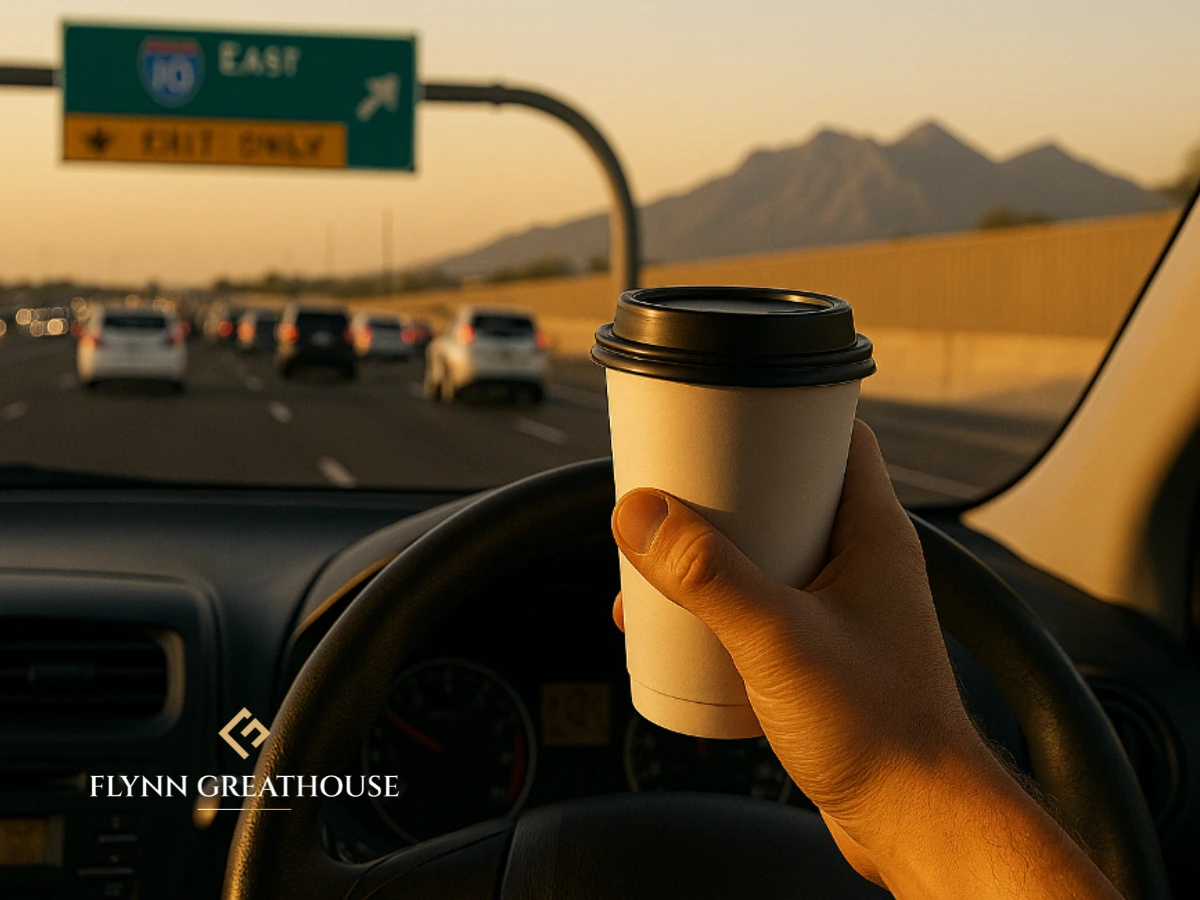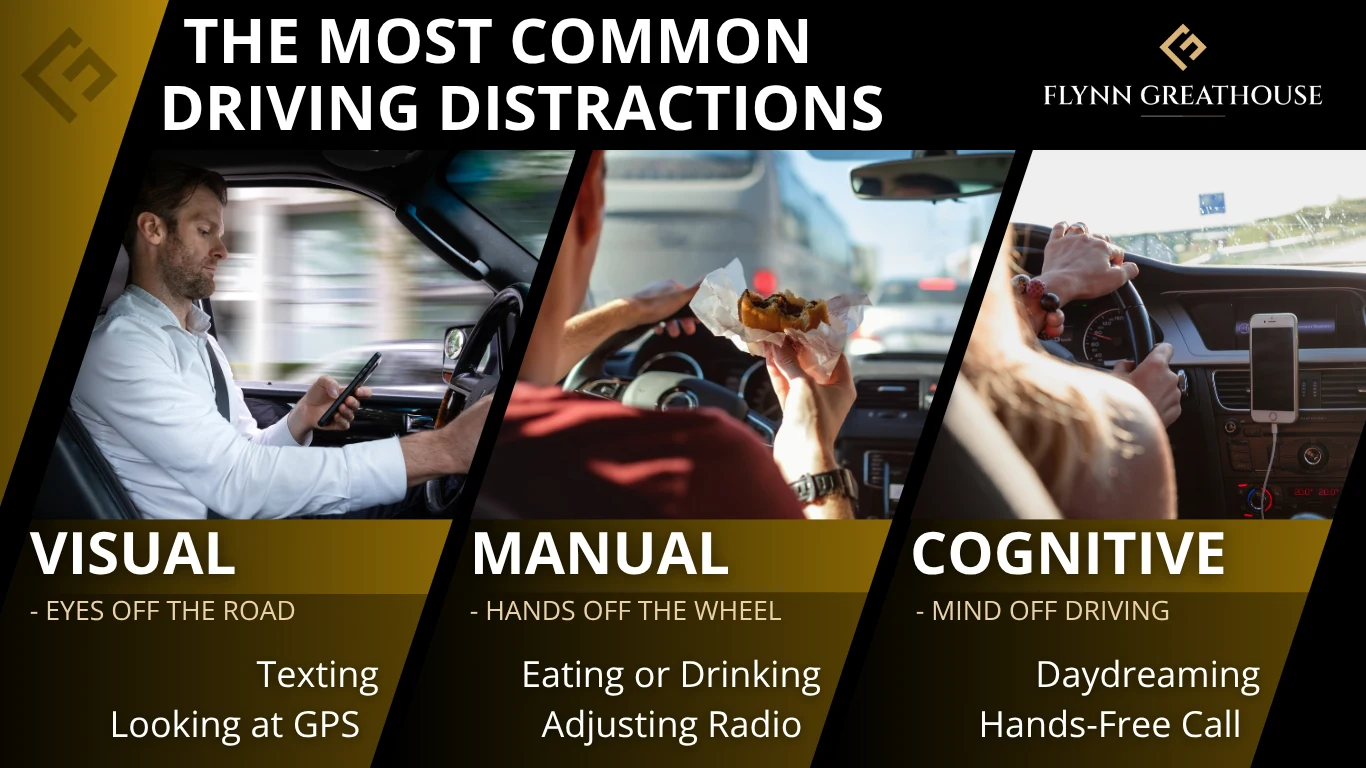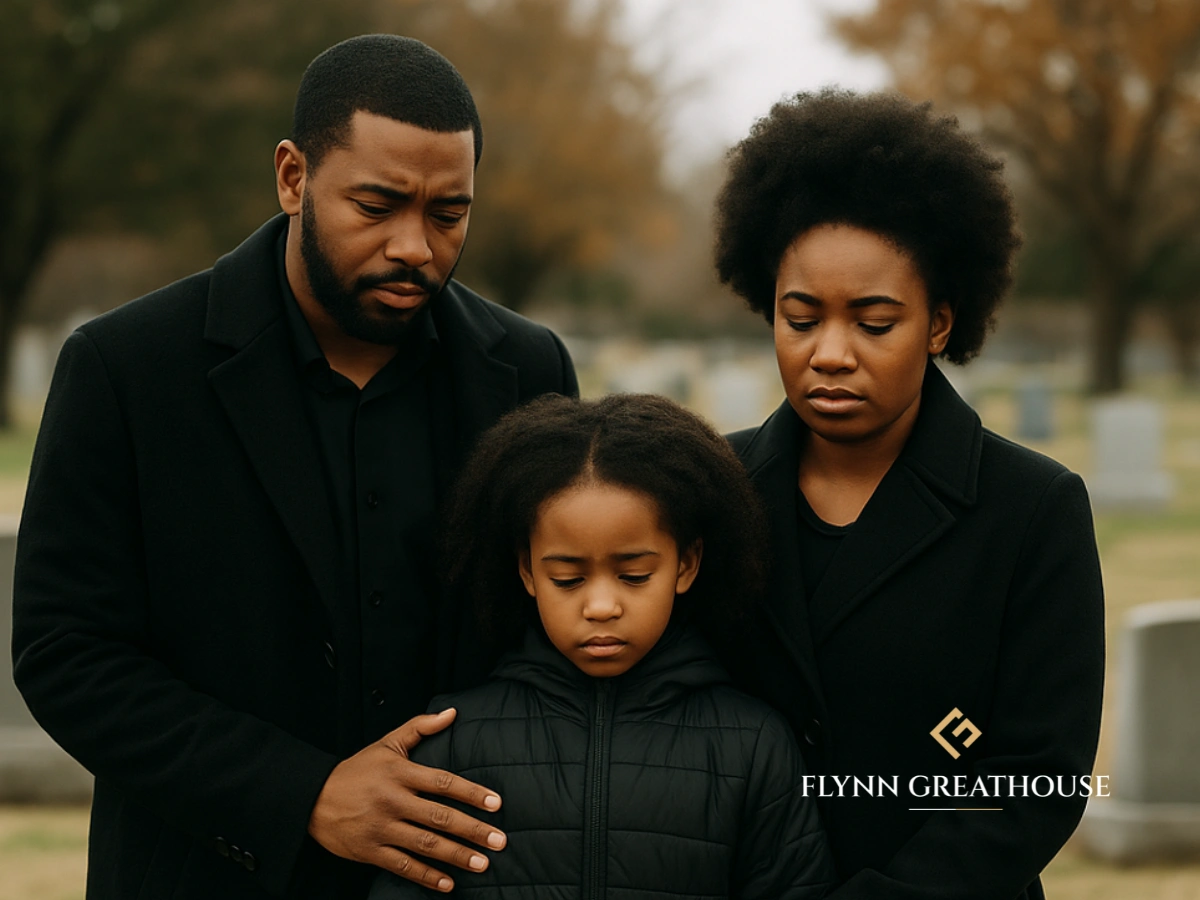What Are the Most Common Driving Distractions in Phoenix, Arizona?
October 15, 2025 – James Flynn, Esq and Riah Greathouse, Esq
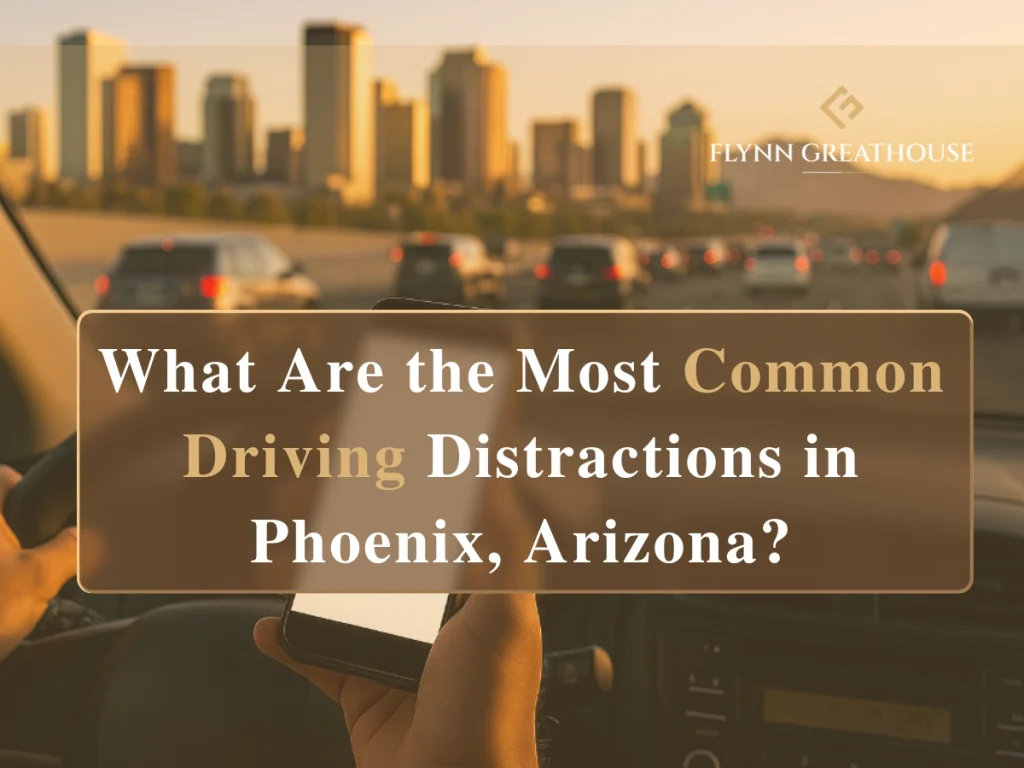
Car accidents in Phoenix are not always caused by reckless speeding or hazardous weather. Many occur in a split second when a driver takes their eyes, hands, or mind off the road. A glance at a phone on I-10, adjusting the radio while driving along Camelback Road, or reaching to grab food on Loop 101 can all trigger a car collision. The result may be more than property damage. A crash often leads to serious injuries, mounting medical bills, and weeks or months of lost wages.
If you or your family member has been affected by a distracted driving crash, you know how quickly ordinary routines can turn into life-changing events. Even for those who haven’t experienced a motor vehicle accident, it’s important to recognize how distraction fuels traffic collisions across Phoenix. Arizona has taken steps to address this danger, with statewide laws designed to prevent crashes before they happen.
By looking at the most common driving distractions, you’ll see not only how they contribute to Phoenix car accident cases, but also what you can watch for on the road and how defensive driving can reduce your risk of becoming a victim.
Distracted Driving Laws in Arizona
Because distracted driving is a major contributor to motor vehicle crashes across Phoenix and the state, Arizona adopted a hands-free rule to limit handheld device use while driving. The prohibition is set out in A.R.S. § 28-914, which bars drivers from physically holding or supporting a wireless communication device while operating a motor vehicle and restricts writing, sending, or reading text-based communications.
Key points under the statute include:
- Drivers may not physically hold or support a portable wireless device while driving.
- Prohibited activities include texting, typing, scrolling social media, and watching videos while operating a vehicle.
- Limited exceptions exist for reporting emergencies and for hands free or voice-based uses such as navigation.
- The law applies even when a vehicle is stopped in traffic or at a signal, unless otherwise allowed by statute.
A violation can show up in police reports, crash reconstructions, and subpoenas for phone records. That kind of evidence often matters in Phoenix car accident claims, where a plaintiff must show the at-fault party failed to exercise reasonable care.
Recent Arizona prosecutions demonstrate how phone data and expert testimony can become central to proving distraction and linking it to a crash. In 2025, prosecutors presented cell phone records and expert analysis in the high-profile Oro Valley fatal crash, and the defendant was later sentenced. In that case, phone activity was a focal point of trial testimony and evidence used by investigators and prosecutors.
Because phone metadata and police observations can support allegations of negligence in a personal injury claim or wrongful death lawsuit, investigators and Phoenix car accident attorneys frequently seek phone records, social media logs, and other device data when a collision leads to serious injuries or death.
How Big a Problem Is Distracted Driving — Nationally and in Arizona?
The Centers for Disease Control and Prevention groups distractions into three types: visual, manual, and cognitive. Researchers and law enforcement use that framework when investigating crashes. (CDC)
At the national level, the most recent comprehensive federal data comes from the National Highway Traffic Safety Administration and its 2023 CrashStats summary. In 2023, an estimated 3,275 people were killed in distraction-affected crashes and roughly 324,819 people were injured. In that year distraction affected about 8 percent of fatal crashes, 13 percent of injury crashes, and 13 percent of all police-reported crashes. Those figures are the baseline investigators and attorneys use when looking at distracted driving as a cause of collisions. (CrashStats)
Arizona’s own crash data provides a closer look at how distracted behavior shows up on state reports. The Arizona Department of Transportation’s 2024 Motor Vehicle Crash Facts report (published July 2025) breaks down the types of distraction recorded by investigating officers. That report shows results across 236,193 driver records used in the analysis and includes these counts and percentages:
- Not distracted: 182,914 drivers, about 77.44 percent of the sample.
- Other activity with an electronic device: 1,008 drivers (0.43 percent).
- Manually operating an electronic device: 627 drivers (0.27 percent).
- Talking on a hand-held device: 261 drivers (0.11 percent).
- Talking on a hands-free device: 187 drivers (0.08 percent).
- Other – inside the vehicle (eating, drinking, etc.): 1,987 drivers (0.84 percent).
- Distracted unknown reason: 2,089 drivers (0.88 percent).
The report also shows a large “Unknown” category for distraction status in many crashes, reflecting limits of what officers can determine at the scene. (Arizona Department of Transportation)
Those Arizona numbers are useful for several reasons. First, they show which distraction types officers record most often on crash reports. Second, they reveal a common investigative problem: many crashes list distraction status as unknown or unreported, and that undercount means device use and other distractions are often underrepresented in official statistics. That’s why prosecutors, plaintiffs, and defense lawyers frequently ask for phone metadata, vehicle telematics, surveillance video, and witness statements to fill the gaps police reports leave behind.
In short, national and Arizona data confirm that distracted driving remains a consistent and measurable contributor to fatal and injury crashes. For Phoenix crash victims and their families, those statistics translate into the practical realities of proving negligence, documenting medical expenses and lost wages, and negotiating with auto insurance companies that may question whether distraction caused the collision.
The Most Common Driving Distractions
The numbers show how widespread distracted driving is, but statistics alone don’t tell the full story. On Phoenix roadways, the distractions that federal and state agencies track often show up in police reports, crash reconstructions, and personal injury cases. From crowded downtown intersections to high-speed stretches of I-10 and Loop 101, drivers face countless opportunities to lose focus for just a few seconds. Those moments are often the difference between reaching your destination safely and being involved in a motor vehicle crash.
Visual Distractions
Visual distractions take your eyes off the road, even if only for a second. In Phoenix, that second can be all it takes to miss a cyclist in a bike lane or a child stepping into a crosswalk. Common examples include:
- Looking at a text or notification
- Checking GPS directions
- Watching something roadside, such as another crash on I-17
- Turning to look at a passenger or child in the back seat
Crash reports often note when a driver admitted they were “looking down” or “checking GPS.” That evidence can support a finding of negligence in a car accident case. When visual distractions cause a car collision, accident victims may suffer serious injuries such as traumatic brain injuries or fractures that require long-term treatment.
Manual Distractions
Manual distractions occur when your hands leave the wheel. While many drivers think they can multitask, Phoenix traffic makes even small mistakes dangerous. Examples include:
- Eating or drinking while driving, common during long commutes on I-10
- Adjusting the radio or climate controls during the summer heat
- Reaching for items in the glove box or back seat
- Grooming, such as fixing hair or makeup at a stoplight
Losing control for even a moment can trigger multi-vehicle accidents or truck accidents, especially during rush hour. Police reports sometimes document food wrappers, spilled drinks, or grooming items found at the scene, giving attorneys supporting evidence to prove negligence.
Cognitive Distractions
Cognitive distractions happen when your mind is not fully on driving. Unlike visual or manual distractions, these can be harder to detect because drivers often appear outwardly attentive. Examples include:
- Daydreaming or “zoning out” during long stretches of desert highway
- Talking on a hands-free call and losing focus
- Stressing about work deadlines or personal issues
- Deep conversations with passengers
Even with eyes on the road and hands on the wheel, a distracted mind delays reaction times. In Phoenix car accident cases, witness statements often reveal that the at-fault driver admitted they were distracted. Examples included that the driver was “thinking about something else” or “wasn’t paying attention.” That kind of evidence can be powerful in establishing negligence and holding the liable party accountable.
Common Injuries From Distracted Driving Accidents
When a driver looks away from the road, takes their hands off the wheel, or loses focus, the results can be devastating. On Phoenix freeways and surface streets alike, distracted driving crashes often happen at higher speeds and with little warning. That combination increases the likelihood of serious injuries for accident victims.
Some of the most common injuries include:
- Whiplash and soft tissue injuries: The sudden stop of a car crash often causes the neck and spine to snap forward and back. Victims may suffer whiplash, strained muscles, or torn ligaments. While some cases heal with rest and therapy, others require months of treatment and can lead to chronic pain.
- Broken bones: Arms, legs, ribs, and hips are especially vulnerable in car collisions. Severe fractures may require surgery, pins, or plates, followed by physical therapy. For many injured parties, time away from work and medical expenses add to the physical pain.
- Traumatic brain injuries (TBIs): Even without direct impact, the force of a car accident can cause the brain to strike the inside of the skull. TBIs range from concussions to permanent cognitive impairment. Medical records documenting headaches, dizziness, or memory loss are often critical in personal injury claims.
- Spinal cord injuries: These can lead to partial or permanent paralysis, changing every aspect of daily life. Victims may require adaptive equipment, long-term care, and ongoing rehabilitation. Future medical treatment and reduced earning capacity often form a large part of compensation demands in Phoenix personal injury lawsuits.
- Internal injuries: Damage to organs such as the liver, spleen, or kidneys may not be immediately obvious at the crash scene. Emergency room doctors often rely on imaging tests to detect internal bleeding. In personal injury cases, timely medical records help establish that these injuries were caused by the accident, not by preexisting conditions.
For a Phoenix lawyer in a car accident, proving the extent of personal injuries goes beyond medical terms. Attorneys often work with doctors, therapists, and vocational experts to show how sustained injuries affect future income, ongoing care needs, and quality of life. That evidence strengthens personal injury cases, wrongful death claims, and negotiations with auto insurance companies that may try to minimize payouts.
How Distracted Driving Leads to Personal Injury Claims
When a distracted driver causes a crash in Phoenix, the impact rarely ends with the accident itself. For many victims, the collision is only the beginning of months or even years of financial and emotional fallout. These ripple effects often become the foundation of personal injury claims.
Common losses include:
- Emergency room bills and ongoing medical expenses: Even a trip to the ER can leave families facing thousands of dollars in costs. More serious injuries such as traumatic brain injuries or spinal cord damage often require follow-up surgeries, physical therapy, and future medical treatment. Those expenses form a large part of the damages sought in a car accident case.
- Lost wages and reduced future income: Phoenix car accident victims often miss weeks of work while recovering. In more severe cases, permanent injuries may prevent someone from returning to their previous job or limit their earning capacity long term. Attorneys frequently work with vocational experts to calculate these future losses.
- Property damage repair costs: Replacing or repairing a vehicle after an auto accident can add another layer of stress. Insurance companies sometimes undervalue vehicles, making it necessary to push for fair compensation that covers actual repair bills or replacement costs.
- Emotional distress and emotional suffering: Beyond physical harm, many accident victims deal with anxiety, sleeplessness, or post-traumatic stress after a collision. Arizona law recognizes that these intangible harms matter and can be included in personal injury cases.
Arizona follows the rule of pure comparative negligence under A.R.S. § 12-2505. This legal standard allows injured parties to seek compensation even if they share part of the blame. For example, if a driver was speeding but the other driver was texting, fault may be divided between them. The damages awarded are reduced by the injured party’s percentage of responsibility.
Because comparative negligence can directly reduce the amount of monetary compensation available, proving negligence with solid evidence, from phone records to police reports, becomes essential. Phoenix car accident attorneys often highlight distraction as the deciding factor in establishing liability and protecting their client’s right to pursue compensation.
Wrongful Death and Distracted Driving in Arizona
In the most tragic cases, distracted driving ends not in injury but in the loss of life. Fatal crashes leave families facing more than grief. They also bring sudden financial strain and the need to seek accountability for a loss that should never have happened.
Arizona law allows surviving family members to pursue a wrongful death lawsuit when a negligent or reckless driver causes a fatal accident. The right to bring such a claim is found in A.R.S. § 12-611. This statute gives certain relatives, such as a spouse, children, or parents, the ability to hold the at-fault party legally responsible.
Compensation in a wrongful death claim may include:
- Funeral and burial expenses: The immediate costs of laying a loved one to rest can be overwhelming without financial support.
- Lost household income and benefits: Families often rely on the earnings of the deceased to pay bills and maintain stability. Losing that income creates long-term financial challenges.
- Loss of companionship, care, and guidance: Arizona law recognizes that the value of a life extends far beyond wages. Courts allow damages for the irreplaceable relationships that victims provided to spouses, children, and parents.
- Medical bills incurred before death: If the victim received emergency care or other treatment before passing, those expenses can also be part of the claim.
In Phoenix, wrongful death cases involving distracted driving often require a thorough investigation. Attorneys may subpoena phone records, review police reports, and work with crash reconstruction experts to prove that the liable party was distracted. Because insurance companies know the damages in wrongful death lawsuits can be significant, they often fight hard to minimize payouts or dispute liability altogether.
For families, pursuing a wrongful death action is not only about recovering financial losses. It’s also about holding negligent parties accountable and preventing similar tragedies on Arizona roads.
How Insurance Companies Handle Distracted Driving Claims
After a distracted driving crash, one of the first calls most accident victims get is from the insurance company. Adjusters may sound helpful at first, but their goal is to limit payouts, not to cover each loss you’ve suffered. That’s why dealing with insurers after a Phoenix car accident can feel like another battle on top of recovery.
Here are a few common tactics auto insurance companies use in distracted driving cases:
- Questioning whether distraction can be proven: Because distraction often isn’t obvious unless there’s phone data, photos, or witnesses, insurers may argue there’s no proof their driver was negligent.
- Downplaying medical expenses: Insurers may claim your medical bills are inflated or that you don’t need future medical treatment, even when doctors recommend it.
- Blaming the victim: Under Arizona’s pure comparative negligence rule, insurers often argue you share some fault for the crash, which reduces the amount they have to pay.
- Pressuring you into a quick settlement: It’s common for adjusters to offer fast payouts that cover vehicle repairs but don’t account for long-term medical care, lost wages, or emotional suffering.
Insurance companies review police reports, witness statements, and sometimes even social media posts to look for ways to weaken your claim. But they rarely volunteer key information, like the fact that phone records or traffic camera footage could prove distraction. That’s why having a Phoenix car accident lawyer on your side makes such a difference. An attorney can demand the evidence needed, challenge lowball offers, and push for a fair settlement that covers the full scope of your losses.
For accident victims in Phoenix, understanding how insurers operate is one step toward protecting your legal rights. The next step is building the strongest possible case to prove negligence and seek compensation for your injuries, lost income, and long-term needs.
Proving Negligence in Distracted Driving Accidents
For accident victims in Phoenix, success in recovering compensation often depends on one thing: proving the other driver was negligent. That means showing not only that the crash happened, but that distraction played a direct role in causing it. Because distracted driving can be harder to prove than something like running a red light, building a strong case requires a thorough investigation and the right evidence.
Attorneys and investigators often look to several sources, including:
- Phone records: Subpoenas can show if the at-fault party was texting, scrolling, or making a call at the time of the crash.
- Police reports: Officers sometimes note if a driver admitted to being distracted or if evidence like an open food container, a phone, or earbuds were visible at the scene.
- Witness statements: Bystanders or passengers may recall that the driver looked down or appeared distracted just before the collision.
- Crash reconstruction experts: Specialists can use skid marks, vehicle damage, and timing analysis to determine whether distraction caused delayed reactions.
- Medical records: Linking the injured person’s sustained injuries directly to the collision helps establish the damages that stemmed from the driver’s negligence.
Arizona’s pure comparative negligence rule makes this process even more important. If an insurance company can argue you were partly responsible, your potential monetary compensation is reduced by your percentage of fault. Establishing negligence with clear evidence not only strengthens your claim but also limits opportunities for insurers to shift blame.
Proving negligence isn’t about one piece of evidence. It’s also about connecting the dots. A Phoenix injury law firm may combine phone logs, police reports, and expert testimony to create a complete picture of what happened. That approach can make the difference between an insurance company denying liability and a legal team recovering fair compensation for medical bills, lost wages, property damage, and emotional suffering.
How to Reduce Your Risk of Distracted Driving in Phoenix
While you can’t control what other drivers do, you can take steps to lower your own risk and spot signs of distracted driving around you. Defensive driving isn’t just about following traffic laws. You need to anticipate hazards on busy Phoenix roads.
Here are some practical tips:
- Set up before you drive: Program your GPS, adjust your mirrors, and set the radio or climate controls before leaving the driveway. That way, you’re not fumbling with buttons in traffic on Loop 202 or I-17.
- Put the phone out of reach: Even with hands-free technology, a buzzing phone can pull your attention away. Stash it in the glove box or set it to “Do Not Disturb” so you’re not tempted to check notifications at a red light.
- Plan meals outside the car: Eating during a commute may feel like a time-saver, but food and drinks are among the most common manual distractions. Take the extra few minutes to eat before or after your drive.
- Watch for weaving vehicles: If you see a car drifting between lanes, slowing unexpectedly, or failing to react to green lights, the driver may be distracted. Give them extra space and avoid driving directly alongside them.
- Take mental breaks: Long stretches of desert highway can make it easy to zone out. Pull over for a few minutes if you feel your focus slipping, especially on late-night or early-morning drives.
These habits won’t stop every collision, but they can reduce the chances of being caught in a distracted driving crash. And if another driver’s negligence still causes an accident, taking these precautions helps show that you were acting responsibly when pursuing a car accident claim.
Flynn Greathouse: Holding Distracted Drivers Accountable in Phoenix
When another driver’s distraction leads to a crash, you’re left with more than a damaged vehicle. You may be facing painful injuries, mounting medical bills, and pressure from the insurance company to settle quickly. Distracted driving is preventable, and drivers who take their eyes, hands, or minds off the road should be held accountable when their choices cause harm.
At Flynn Greathouse, our Phoenix car accident attorneys focus exclusively on motor vehicle accidents, including auto collisions, truck accidents, motorcycle crashes, and multi-vehicle accidents. Our legal team knows how to prove negligence in distracted driving cases by using police reports, phone records, witness statements, and expert analysis. We push back when insurers try to minimize your claim, and we fight for fair compensation to cover medical expenses, lost wages, and future medical treatment.
If you’ve been searching online for a “personal injury lawyer near me” after a distracted driving accident in Phoenix, call (888) 823-4529(888) 823-4529 or contact us online to schedule your free virtual consultation. Flynn Greathouse is here to investigate your case, protect your legal rights, and pursue the compensation you need to cover medical bills, lost wages, and future care.
We’ll handle the legal side while you focus on moving forward.
Copyright © 2025. Flynn Greathouse. All rights reserved.
The information in this blog post (“post”) is provided for general informational purposes only and may not reflect the current law in your jurisdiction. No information in this post should be construed as legal advice from the individual author or the law firm, nor is it intended to be a substitute for legal counsel on any subject matter. No reader of this post should act or refrain from acting based on any information included in or accessible through this post without seeking the appropriate legal or other professional advice on the particular facts and circumstances at issue from a lawyer licensed in the recipient’s state, country, or other appropriate licensing jurisdiction.
Flynn Greathouse
2 N Central Ave, Suite 1844
Phoenix, AZ 85004
(602) 777-3476
(888) 823-4529(888) 823-4529
http://mycaraccidentattorneys.com/
Related Blog Posts

How Is Liability Determined in a Phoenix Car Accident?
You didn’t leave your home expecting to be in a Phoenix car accident. Maybe you were running a quick errand, heading home from work, or picking up the kids. Then, in…
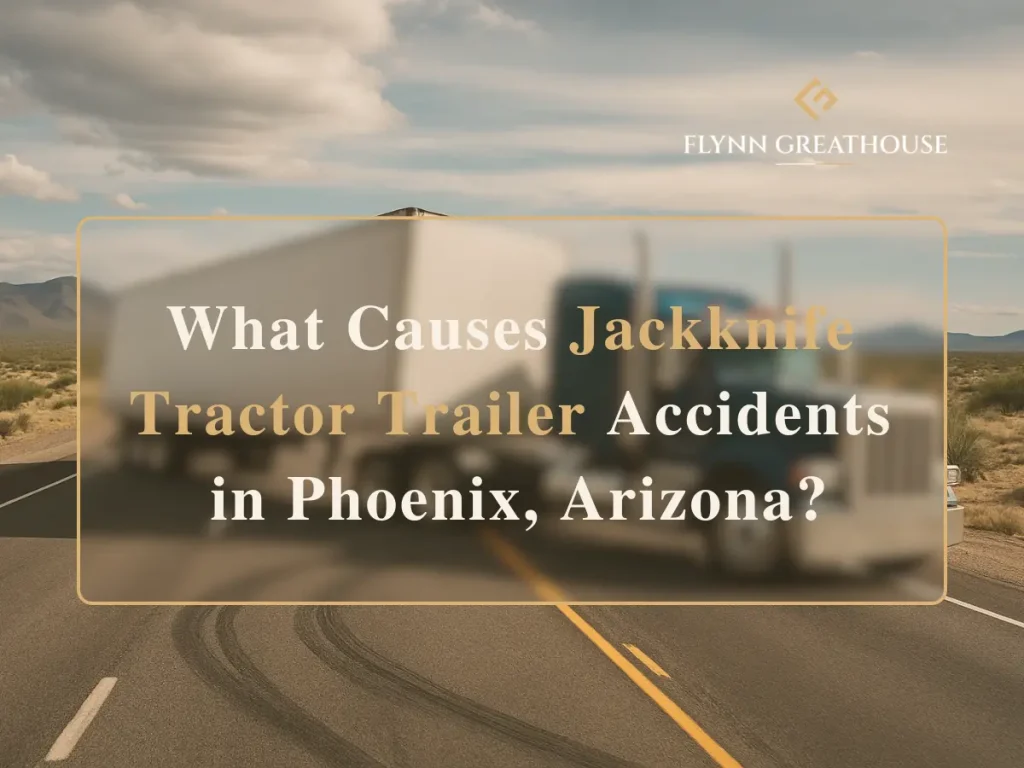
What Causes Jackknife Tractor Trailer Accidents in Phoenix, Arizona?
It only took a second. You were heading down I-10 when a tractor trailer in the next lane lost control. The trailer began to swing, folding in toward the cab…
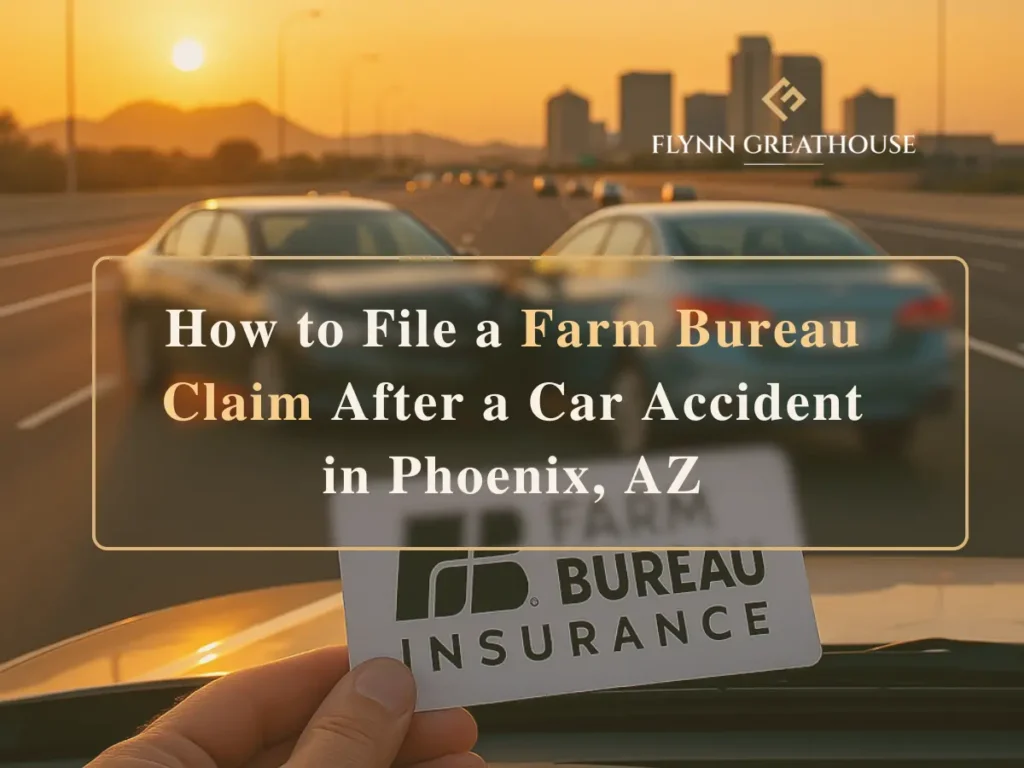
How to File a Farm Bureau Claim After a Car Accident in Phoenix, AZ
If you’ve been in a car accident in Phoenix, Arizona, you may be juggling more than just physical pain. Between the insurance paperwork, police reports, medical visits, and vehicle repairs,…
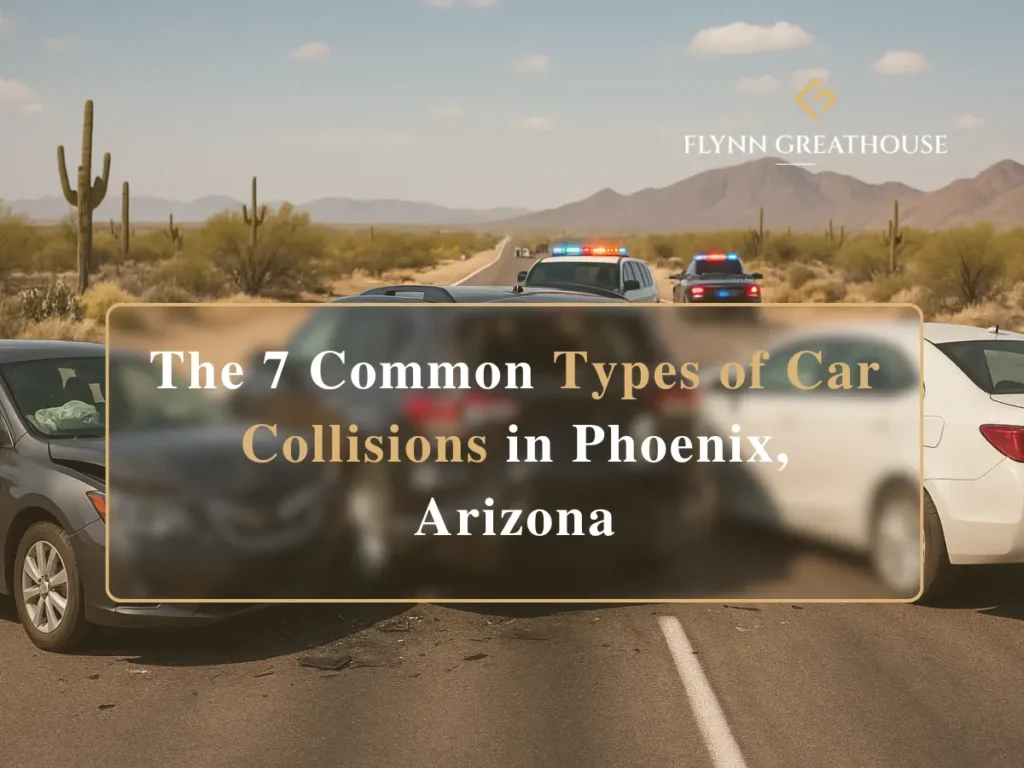
The 7 Common Types of Car Collisions in Phoenix, Arizona
A stretch of desert highway. Three crumpled cars. Police lights flashing against a backdrop of cactus and mountains. It’s the kind of scene you pass by and hope never to…
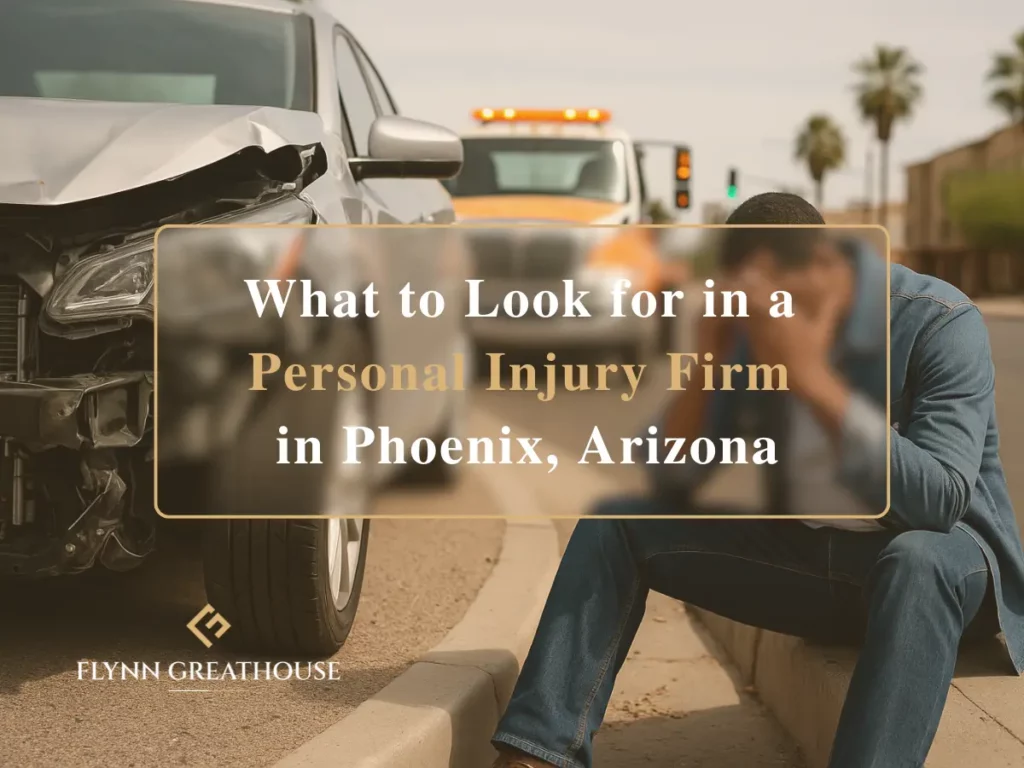
What to Look for in a Personal Injury Firm in Phoenix, Arizona
After a car crash, you might start out thinking the insurance company will handle everything, from the paperwork to paying what’s fair. But if your injuries aren’t getting better, the…



